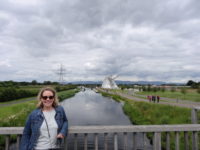 When she turned forty, Meredith told me she wanted to go to all the countries in Europe that are covered by a Rick Steves guidebook – something like fifteen countries (or regions) in all. She said I could choose where we went every year, but it had to from one of the books, and we could not repeat a country unless we had done a new one already during the year. Fair enough.
When she turned forty, Meredith told me she wanted to go to all the countries in Europe that are covered by a Rick Steves guidebook – something like fifteen countries (or regions) in all. She said I could choose where we went every year, but it had to from one of the books, and we could not repeat a country unless we had done a new one already during the year. Fair enough.
Scotland made its way to the top of the list for several reasons. It was a new book to the Rick Steves canon, so Mer was not aware it was an option. They also (mostly) speak English in Scotland, which, after several trips of my not being able to communicate, was a definite plus. Finally, and this is not to be underestimated after last year being so hot in Austria, Scotland is cool. It is cool to the degree that it looks like we will not see 70 during our stay here. I love it.
All that to say that I slept very well last night, and enjoyed burrowing under a blanket. After a fine breakfast and our getting ready, we checked out and grabbed a bus back into the old city to pick up our car. We were a little startled to see a line in the office; it turns out this was, for some reason, their busiest day of the year so far, with more than seventy rentals before noon. We waited about thirty-five or forty minutes to get our car, and as far as I could tell, no one in the line was getting visibly upset.
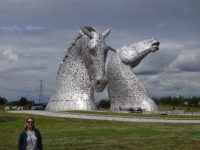 Let’s check off the rental car fun! Make you have never heard of. Check. Steering wheel on the wrong side. Check. Left-hand shifter with backwards pattern. Check. Add to the mixture one moderately congested old city, sprinkle liberally with roundabouts seemingly every half-mile, and shake well with driving on the left-hand side of the road. Good times. At least for today, there was only one panic stop, which of course happened as I was trying to merge on a roundabout (I was checking ahead of me to see if anyone was merging ahead and almost missed the car coming at me as I was trying to merge). Meredith was probably pleased to be treated to a low-level rant for much of an hour as we drove to Falkirk.
Let’s check off the rental car fun! Make you have never heard of. Check. Steering wheel on the wrong side. Check. Left-hand shifter with backwards pattern. Check. Add to the mixture one moderately congested old city, sprinkle liberally with roundabouts seemingly every half-mile, and shake well with driving on the left-hand side of the road. Good times. At least for today, there was only one panic stop, which of course happened as I was trying to merge on a roundabout (I was checking ahead of me to see if anyone was merging ahead and almost missed the car coming at me as I was trying to merge). Meredith was probably pleased to be treated to a low-level rant for much of an hour as we drove to Falkirk.
Falkirk, as it turns out, is the home of Helix Park, which in turn is home to the Kelpies, the world’s largest horse sculpture. I did not know where we were going or why, so when I was very suddenly confronted with two horse heads one hundred feet high, it made an impression. A very positive one. I love sculpture, and then I love it more when it is outside, and then I love it even more when it looks like something. The Kelpies sculpture is modern, but shows off strength and emotion in a work where you get what is normally a grass-eye view of things. On top of all of that, we got a guided 30-minute tour, which included going inside the smaller of the two heads (Duke, as opposed to Baron, the other horse). Brilliant – we got to see the structure of the sculpture, which was an intended part of the work from the beginning; the artist wanted the public to be able to see inside.
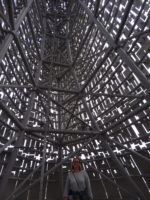 For those wondering about the title, kelpies are water spirits that can change shape, and when they are above water, they look like horses. If a person tried to ride the kelpie, he got stuck to its back and was then drowned and eaten. Good myth. Since the two horses in this work are on either side of a working canal, the water-horse myth seemed like a good one. In addition, the artist wanted to pay tribute to all of the working horses that helped on the canal. I flat-out loved it, and we were there for about two hours (which included a light lunch). Oh – for those who worry or are curious about cost, the sculpture cost about five million pounds. It has brought in three million visitors in three years. That is a good investment in public sculpture.
For those wondering about the title, kelpies are water spirits that can change shape, and when they are above water, they look like horses. If a person tried to ride the kelpie, he got stuck to its back and was then drowned and eaten. Good myth. Since the two horses in this work are on either side of a working canal, the water-horse myth seemed like a good one. In addition, the artist wanted to pay tribute to all of the working horses that helped on the canal. I flat-out loved it, and we were there for about two hours (which included a light lunch). Oh – for those who worry or are curious about cost, the sculpture cost about five million pounds. It has brought in three million visitors in three years. That is a good investment in public sculpture.
Since Falkirk is a mid-sized working town, you would think that the Kelpies would be the end of the tour, but you would be wrong. Falkirk, on the far side of 3,217 roundabouts, is home of the world’s first and only boat elevator, the Falkirk Wheel. It is a marvel of clever engineering, and its job is to lift (or lower) canal boats up from one canal up about a hundred feet in the air to another canal. It opened in 2002, replacing a much earlier and now filled-in series of eight locks. Scotland takes the canals, which are now mostly for pleasure use, very seriously. They had been closed in the 1960s, but made a comeback in the 1990s, and the Wheel rejoined two major canal systems again.
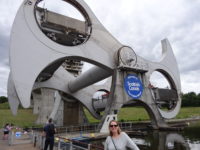 It does this through balancing two huge tubs of water that boats maneuver into. The tubs, 180 degrees apart on a circle, then seal up and rotate around, bringing boats up and down at the same time. Since the tubs are balanced to weigh the same, it takes less than a dollar’s worth of electricity to rotate the whole system halfway around. “Ah!” you say. “What about the weight of the boat?” The boat displaces its weight in water, which is how something floats. So, the sixty-ton boat pushes out sixty tons of water from the tub, and so the tub ends up always weighing the same no matter what boat is in the system (or if there’s no boat at all).
It does this through balancing two huge tubs of water that boats maneuver into. The tubs, 180 degrees apart on a circle, then seal up and rotate around, bringing boats up and down at the same time. Since the tubs are balanced to weigh the same, it takes less than a dollar’s worth of electricity to rotate the whole system halfway around. “Ah!” you say. “What about the weight of the boat?” The boat displaces its weight in water, which is how something floats. So, the sixty-ton boat pushes out sixty tons of water from the tub, and so the tub ends up always weighing the same no matter what boat is in the system (or if there’s no boat at all).
Of course, you can buy a ride on a boat to then ride the Wheel up, take a short ride on the canal (through a tunnel in a mountain), and then come back and go down the Wheel. Not too surprisingly, we did just that. The ride down is eerie because for half the ride there is very little to gauge movement against. Once the ride is halfway down, you can see the center axle of the Wheel, and then can easily tell you are moving. When the Wheel was built, it was just to move boats; it was not a tourist attraction. But the curious kept coming, and so a small complex sprang up around it. I loved that right in front of the Wheel was a fully working and active canal lock that I got to see in operation twice. Nifty.
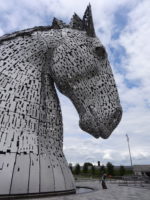 With that, we made our roundabout way to Stirling, where we checked into our B and B. We walked the mile or so into the main town center and ate supper before walking back to the B and B, where we had to buy a permit from a machine for parking for the next day. I was a pound short in coins. Back into town we went to buy dessert, and then back again to the machine. We are now legally parked outside out the B and B, which is its own form of engineering feat.
With that, we made our roundabout way to Stirling, where we checked into our B and B. We walked the mile or so into the main town center and ate supper before walking back to the B and B, where we had to buy a permit from a machine for parking for the next day. I was a pound short in coins. Back into town we went to buy dessert, and then back again to the machine. We are now legally parked outside out the B and B, which is its own form of engineering feat.
Did you get a standard??? Are you mad? I -always- get automatics in Britain – there’s enough to worry about without figuring out shifting.
I didn’t know about the horses (did know about the boat lift). Nifty stuff.
I make up for the standard shift by having a GPS. Then at least I don’t need to worry about looking for signs.
Having a standard came back to haunt me when we parked on a hill and I was trying to go in reverse. I forgot to use the handbrake and we rolled forward instead of reverse, so I thought the gears were messed up, but it was just a high clutch point. Happily a curb caught the front wheels and I figured it out (and remembered the handbrake trick *after*).